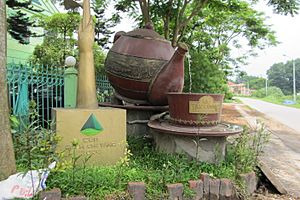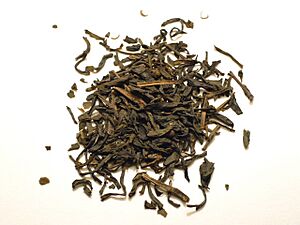Vietnamese tea facts for kids
In Vietnam, drinking Vietnamese tea has long been a special hobby. It was often enjoyed by older, wise people. But guess what? Now, more and more young people are discovering how cool it is! People often drink tea while doing calm activities, like writing poems, taking care of flowers, or just enjoying nature. Vietnamese people usually like teas that are light and smell like flowers, such as green tea or white tea with a floral scent.
Vietnamese teas come from many places known for their beautiful tea gardens. For example, some are found in the huge tea forests of the Lamdong highlands. Here, you can even see ancient houses built a long time ago, in the late 1700s. Vietnam is home to some of the world's oldest tea trees, which are over 1000 years old!
Green tea is super popular in Vietnam. In 2011, it made up over 63% of all tea sold! For a long time, Vietnamese green teas were not well-known outside of Asia. Vietnamese green teas have less caffeine than Chinese green teas, but more caffeine than Japanese green teas. Lately, new businesses are helping to share these amazing green teas with other countries.
The Vietnam Tea Association (VITA) was started on July 19, 1998. Their main goal is to help and protect tea growers, people who buy tea, and tea businesses in Vietnam.
Out of all the places where tea grows (mostly in the Northern and Central highlands), Thái Nguyên is thought to have the very best quality tea in all of Vietnam. Even the French, when they were in charge, thought it was the best in the whole region!
Types of Vietnamese Tea

There are many delicious kinds of tea in Vietnam. Each one has its own special taste and story!
Green Tea
Pure green tea is the most common tea in Vietnam. High-quality Vietnamese green tea, especially from a place called Tân Cương in Thái Nguyên, might taste a bit bitter at first. But then, it changes into a deep, sweet flavor that lasts a long time! Vietnamese green teas are usually very strong. For most people, it's best to brew them for less than 2 minutes using water that's about 70°C (160°F). If you brew it longer, it will get more bitter. Some tea lovers actually prefer this strong, bitter taste because it shows how powerful the tea leaves are! Some people even brew the same tea leaves 3 or 4 times, enjoying the slightly different flavors each time.
Lotus Tea
Lotus tea (called trà sen) is a very special tea from Vietnam. To make it, high-quality green tea leaves are placed inside fresh lotus flowers for a whole day. This lets the tea leaves soak up the beautiful scent of the lotus. Then, the leaves are taken out and packaged. An even fancier lotus tea is made by mixing lotus petals right in with the green tea leaves. Vietnamese green tea leaves are gently rolled into crescent shapes, and they are handled very carefully.
Jasmine Tea
Jasmine tea (called trà lài) is made in two different ways, similar to lotus tea. Jasmine tea has a stronger smell than lotus tea, but lotus tea tastes sweeter. While lotus tea is often saved for special events or meals, jasmine tea is popular after drinking Vietnamese iced coffee. After you finish your coffee, jasmine tea is poured into the glass, chilled, and then enjoyed. This is a common thing to do in coffee shops, especially at night in big cities, where people meet up to chat on warm evenings.
Other Unique Teas
- Trà shan tuyết: This tea is made from very old tea trees found in Ha Giang province.
- Trà sâm dứa: This is a special treat from Central Vietnam. It's a mix of green tea with herbs like jasmine, Aglaia duperreana flower, basil, and pandan leaves.
- Trà atiso (artichoke tea): This is a herbal tea made from the leaves, root, stalk, and flower of the artichoke plant. It's a specialty of the Lam-Dong highland region, where lots of artichokes grow.
- Trà đắng (kuding tea): This tea is called bitter tea because of its taste. It's sometimes given to people who have headaches, high blood pressure, colds, or diabetes because it has healthy antioxidants.
- Chè nụ (Bud tea): This tea is made only from the tiny buds of the tea flower.
- Chè vối: This tea is made from the buds and leaves of the cleistocalyx operculatus tree.
Other common Vietnamese teas that are infused with flowers include chrysanthemum tea (trà cúc), aglaia tea (trà ngâu, made with the flower from the Aglaia duperreana plant), and trà sói, which is infused with a flower from the Chloranthaceae family.
br:Te Viet Nam


